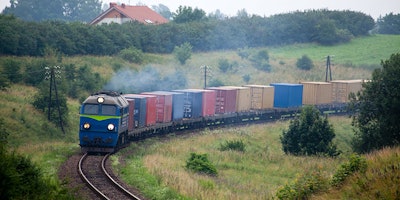
 Jenny Vander Zanden
Jenny Vander ZandenLast year was a challenging one for shippers of all types. An increasing number of 2018 earnings calls from Fortune 500 companies pointed to rising transportation costs as a reason for falling short of financial expectations.
Fuel and freight expenditures can be difficult to manage due to the mixed signals and volatility commonly experienced in the transportation industry. These challenges are further amplified in food manufacturing where margins are tight and unexpected costs in the transportation segment of the supply chain cut into profits.
Most food manufacturers are under pressure to reduce costs, and adjusting your transportation strategy by considering intermodal offers opportunities for significant savings. A growing number of shippers are capturing the value in switching to rail to drive down costs, consumption, and emissions. Month-to-month increases in intermodal adoption trace back to February 2017, and market research from Technavio indicates intermodal freight transportation will grow at an annual rate of 7 percent (CAGR) through 2022.
But, where exactly does intermodal fit into a food shipper’s transportation strategy?
Why Intermodal is an Attractive Option for Food Shippers
Shipping dry or packaged goods over a long haul is the most advantageous way to implement intermodal transportation. Historically, intermodal came with increased transit times compared to over-the-road shipping. Switching modes seemed less viable for products with a limited shelf life, such as fresh produce and refrigerated goods. But the cost savings were impressive if a little extra time in transit was not a concern for the products. Now, advancements in intermodal operations and equipment are changing the landscape and making intermodal a more feasible option for refrigerated goods.
While not all rails or terminal locations are equal, intermodal service options have improved, and rail has become a worthwhile option on shorter shipments in the 500- to 1,000-mile range. The biggest opportunities, however, exist in the potential to dramatically reduce volatile fuel costs, consumption, and emissions from a food manufacturer’s supply chain via intermodal.
While switching modes to rail transport sometimes increases transit time by a day or two, the reality is that intermodal shipping is becoming quite competitive with truckload. A 2018 report from the USDA showed rail carriers invested in cold storage distribution facilities and equipment as well as expanded services to meet demand.
Produce can be challenging to ship via intermodal due to the lower shelf life of the product. Raw commodities, such as grain, can be difficult to covert to intermodal because of the product’s specialty storage requirements. Though it is harder to convert these products to intermodal, they often fit well into a traditional rail program, especially if the manufacturer has rail siding available at their facilities.
 Intermodal shipping offers benefits to food shippers
Intermodal shipping offers benefits to food shippersThe Real Benefits of Intermodal Shipping for Food Manufacturers
Cost and Consumption Benefits: Data shows the cost of the fuel used in intermodal tends to be about 60 percent less than over-the-road. This is largely due to the fact that intermodal experiences more efficient consumption, and rail is not subject to on-highway tax. Since fuel makes up as much as 30 percent of a shipper’s transportation budget, reducing this cost can have a significant impact on a shipper’s bottom line.
Consumption is also reduced through intermodal because it requires less fuel, and that fuel is used more efficiently. Switching to rail results in a reduction of energy consumption by as much as 50 percent.
In addition to a lower cost of fuel, operating costs are lower on the rail, thanks to the introduction of things like stack train economics and mechanized terminals, which have greatly improved productivity.
Sustainability Benefits: Better fuel efficiency and reduced consumption associated with intermodal shipping contribute directly to improved sustainability in a shipper’s transportation network. Like fuel consumption, CO2 emissions can be reduced by as much as 50 percent when comparing intermodal to truckload shipping.
Reducing transportation emissions through the use of intermodal shipping is an effective way to bring value to both your retail customers and consumers by contributing to their sustainability goals. Major retailers seek suppliers with sustainability initiatives in place that contribute to their corporate sustainability goals. Furthermore, certain consumers seek out and support brands that are making strides to be more sustainable.
Utilizing intermodal has the additional sustainability-related benefit of reducing greenhouse gas emissions through the removal of trucks from the road and the associated congestion on highways and in major U.S. cities. It is estimated that one double-stack intermodal train removes about 280 trucks from interstate highways.
Capacity Benefits: An intermodal transportation strategy provides shippers with an option to diversify the organization’s transportation portfolio with an additional mode of transport. With traditional truckload, drivers are limited by hours-of-service regulations. Those restrictions contribute to capacity constraints in over-the-road but are not a concern with rail transportation. This advantage helps offset intermodal transit delays, an important consideration for fresh and frozen food, and makes switching modes a more competitive option.
Improving Transparency for Fuel and Freight
Accurate data and true transparency are crucial elements of a transportation strategy involving intermodal shipping. Instead of using a traditional fuel surcharge program based on the Department of Energy (DOE) index, shippers can break intermodal up into drayage and rail segments, gaining true visibility with market-based pricing.
Food manufacturers that adopt intermodal shipping as a part of their transportation strategy stand to gain a competitive edge. However, shippers should consider the impact at the lane level before converting to rail. Use transportation data and market intelligence to identify the most effective ways to move goods to market, operationalize according to organizational goals, and continuously measure over time to assure results.
Jenny Vander Zanden is Chief Operating Officer at Breakthrough Fuel.




















